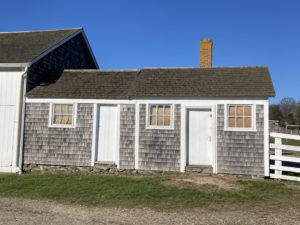 Casey Farm
Casey Farm
People Who Work the Land
From what we know about this farm and ones like it when it was founded in the first decades of the eighteenth century, a variety of crops were grown relying on the labor of enslaved Indigenous and African people. Professor Christy Clark-Pujara in her book Dark Work: The Business of Slavery in Rhode Island described what is also evident in the archives for Casey Farm:
Located along the southeastern coast of Rhode Island, the Narragansett Country—also known as South County—was first cleared and farmed by Native Americans. The region’s rich soil, moderate temperatures, and easy access to Newport trade made it an ideal place for large-scale commercial agriculture and grazing. There was no staple crop. Instead farmers bred horses, cattle, and sheep, manufactured dairy products (primarily cheese), and cultivated small amounts of Indian corn, rye, hemp, flax, and tobacco. Slave labor was essential to the economy in the Narragansett, as slaves produced nearly all the exported goods. (page 26)
Although the 1790 census for the state indicates there was a small number of enslaved people residing in Rhode Island, the presence of many of Silas Casey’s laborers are listed separately in the census under the column of “other free persons,” suggests that he was no longer a slaveholder.
Tenant Farmers and Hired Hands
 It is documented that Casey Farm was mainly worked by tenants, some African American, some Native American, some of European descent, throughout its history. In addition, Silas Casey’s records show payments to twenty-seven men (nine of whom were identified as people of color) working as hired hands. These farmers produced corn, wheat, rye, barley, apples, raised sheep, dairy cows, and made famous Narragansett cheese.
It is documented that Casey Farm was mainly worked by tenants, some African American, some Native American, some of European descent, throughout its history. In addition, Silas Casey’s records show payments to twenty-seven men (nine of whom were identified as people of color) working as hired hands. These farmers produced corn, wheat, rye, barley, apples, raised sheep, dairy cows, and made famous Narragansett cheese.
One person of color that appears often in the account books over a span of fifteen years is Cuff Gardner. He did a variety of work on the farm, from killing hogs and butchering, to carting wood, setting apple trees and trimming the orchard, and building the orchard wall. He was paid in cash as well as salt, corn, and potatoes. Prof. Clark-Pujara gives us insight into life in Rhode Island as a free person of color like Cuff Gardner:
The vast majority of black and mixed-race Rhode Islanders…were free by the turn of the nineteenth century; however, free was a terribly relative term. People of color still had to contend with slavery on multiple levels. The practice of slavery still continued, as did statuatory slavery. Free blacks also had to cope with the legacies of slavery—most urgently the poverty that came with nothing but freedom. Moreover, being free did not mean having rights. Free blacks had ambiguous legal protections because they were not universally recognized as citizens…Interracial marriages were banned in 1789, and African American men were barred from voting in 1822. (page 94)
In 1804 Silas Casey noted Cuff’s “lost days,” which included “Negro Election” and “Negro Town Meeting,” and a half day lost to being unwell. By reading deeper, we see glimpses of personal time and social life, particularly the regular participation in Negro Election festivities.
Silas Casey entered into agreements with two men of color who worked as tenant farmers: Henry Niles (whom Casey identifies as a Native American) and Henry Carr (a free African American). Both men lived in a small house about a half mile from the main farm house rent-free in return for working for Casey a specific number of days per week. A display about the lives of Mr. and Mrs. Henry Carr as interpreted through archaeology is in the Casey Farm House Museum Gallery.